
ELECTRICAL CLASSROOM
A complete Electrical Engineering portal

MCB Trip Curves – B, C, D, K, and Z trip curves
MCB (Miniature circuit breaker) is a re-settable device designed to protect a circuit from short circuits and overcurrents. The trip curve of an MCB (B, C, D, K, and Z curves) tells us about the trip current rating of Miniature Circuit breakers. The trip current rating is the minimum current at which the MCB will trip instantaneously. It is required that the trip current must persist for 0.1s.
Class B trip curve
Class c trip curve, class d trip curve, class k trip curve, class z trip curve, class a trip curve, importance of mcb trip curve types, trip curves for other circuit breakers.
The MCB trip curves, also known as I-t tripping characteristic consist of two sections viz, overload section and short circuit section. Overload section describes the trip time required for various levels of overload currents and the short circuit section describes the instantaneous trip current level of MCB.
Read More: Miniature Circuit Breaker (MCB) – Principle of operation
The MCB with class B trip characteristics trips instantaneously when the current flowing through it reaches between 3 to 5 times the rated current. These MCBs are suitable for cable protection.
MCB with class C trip characteristics trips instantaneously when the current flowing through it reaches between 5 to 10 times the rated current. Suitable Domestic and residential applications and electromagnetic starting loads with medium starting currents.
MCB with class D trip characteristics trips instantaneously when the current flowing through it reaches between Above 10(excluding 10) to 20 times the rated current. Suitable for inductive and motor loads with high starting currents.
MCB with class K trip characteristics trips instantaneously when the current flowing through it reaches between 8 to 12 times the rated current. Suitable for inductive and motor loads with high inrush currents.
MCB with class Z trip characteristics trips instantaneously when the current flowing through it reaches between 2 to 3 times the rated current. These types of MCBs are highly sensitive to short circuits and are used for the protection of highly sensitive devices such as semiconductor devices.
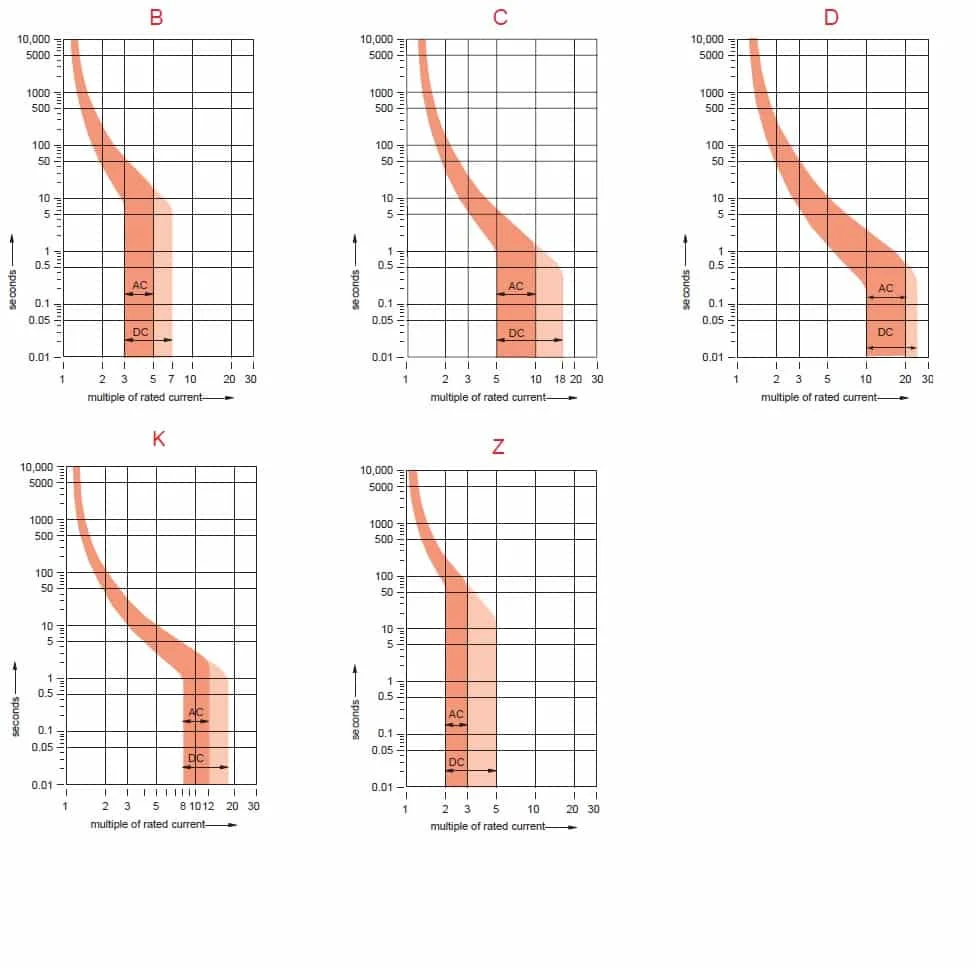
MCB with class A trip characteristics trips instantaneously when the current flowing through it reaches between 2 to 3 times the rated current. Like Class Z MCBs, these are also highly sensitive to short circuits and are used for the protection of semiconductor devices.
MCBs with trip curve class B and trip curve class C is the most commonly used ones. MCBs with Class C trip curves can be found in the lighting power distribution boards in residential and commercial buildings. It trips as soon as the current rises between 5 to 10 times its rated current. Class B MCBs are used in the protection of electronic devices such as PLC, DC power supplies, etc. in control panels. It trips as soon as the current rises between 3 to 5 times its rated current.
In some applications, frequent current peaks occur for a very short period (100ms to 2s). For such applications, class Z-type MCBs shall be used. Class Z-type MCBs are used in circuits with semiconductor devices.
It is important to choose an appropriate MCB current rating and trip curve in order to safeguard the circuit from damage during faults. Hence it is necessary to calculate the short circuit current and inrush current before choosing an appropriate MCB rating. If the chosen MCB rating is much higher than required, then it may not trip in the event of a fault. Similarly, if the MCB is underrated, then it may cause nuisance trips, for example even the starting currents or inrush currents may trip the MCB.
External selection tool: https://new.abb.com/low-voltage/solutions/selectivity/tools-support/curves
All circuit breakers, such as MCCB, ACB, VCB, etc have their own trip characteristics. The only thing is that may not follow the categorization as that of MCB. Also, the circuit breaker curve types are not the same for all types of circuit breakers. It varies from one circuit breaker type to the other and depends on many design factors.
Learn more about MCB:
- What is an MCB?
- Miniature Circuit Breaker (MCB) – Principle of operation
- What is kA rating of MCB and MCCB?
Related Articles: 1. Difference between MCB and MCCB 2. Difference between contactors and relays 3. Difference between Soft Starters and VFDs 4. Difference between MCCB and RCCB 5. Difference between MCB and RCBO 6. Difference between RCCB and RCBO 7. Difference between MPCB and MCCB
27 thoughts on “MCB Trip Curves – B, C, D, K, and Z trip curves”
Very good explanation. I understood the concept. Thank you.
Thank you, Mr. Sanket. Kindly browse through our articles. Please subscribe or follow us on twitter/facebook for instant updates.
Thankhs google team good explace thanks again
Very good mcb make , what Amps load trip make
Very good. Nice explain.. Good job
Explanation is good but your second paragraph doesn’t match the charts. It looks like it is the B-curve that trips between 3-5 times its rated current, and C-curve that trips between 5-10 times its rated current.
Very good, thanks
very good …..thanks
Thanks very much
Very good explanation
Is this curves is applicable to Rccb ?
No. These curves are applicable for mcbs only.
Thanks for your information
The information about mcb is very useful and helpful for a technician, many many thanks for sharing your information.
Great information, I got to know a few more details out of what I wanted to know.
Which type is better choice for UPS protection?
The explanations are very good but in the video is a mistake at minute 0.38. The short circuit sections with the overload section are reversed.
Good for selection of MCB’s
On the c type Mcb on the time curves at a short circuit fault current at 220amp it shows dis connection at 6/7seconds are you saying that disconnection will be instant at this current or 6/7 seconds.
I use B-curve in my home when short circuit occured in the appliace MCB tripped but my appliance burned. My appliance lead wires were shorted by a metal piece was lying on it.I thought MCB could have protected but not. And I also headed big noise of it.
Sorry to hear that. This could be because the MCB was oversized: Much higher than the rated current of the appliance or the MCB could be faulty. We suggest you replace it with a new one. Make sure that you are choosing the right one.
Thanks for sharing such an informative article about MCB.
sir Type C is used for average current load. Type B and C are the most commonly used in DBs. Tripping of MCB Type C is 5-10 times higher than normal. eg: if a 6A mcb put in acircuit , the rated current is 6 A , then how ever the type c mcb with stand 5 to 10 times higherr than normal .
hello, what about the CL curve mcb, because in my home installation I used the cl4 code on the mcb
Perhaps you are referring to product name of the MCB and not its trip curve.
The information is quite educative. Thank you so much
Leave a Comment Cancel reply
- Switch skin
Home > Protection > Tripping Curves of Circuit Breakers – B, C, D, K and Z Trip Curve
Tripping Curves of Circuit Breakers – B, C, D, K and Z Trip Curve
Types of circuit breaker based on its tripping curve.
A circuit breaker is a protection device employed in every electrical circuit to prevent any potential hazard. There are different types of circuit breakers used all over the world due to their various characteristics & applications. It is necessary to have a circuit breaker that offers adequate protection so that one can work safely around it without having fear of any potential hazards. That is why it is best to know about these kinds of circuit breakers & what kinds of protection do they offer before buying one.
Table of Contents
What is a Circuit Breaker?
A circuit breaker is an electrical device that provides protection against fault current. It breaks the circuit in case of overloading & short circuit. The fault currents generated due to these fault conditions can damage the electrical devices as well as cause fire in a building that can also pose danger to human life.
The circuit breaker instantly cut off the power supply to reduce further damage. A circuit breaker has two types of tripping unit i.e. thermal and magnetic tripping unit.
Thermal Tripping Unit: the thermal tripping unit is used for protection against overloading. It uses a bi-metallic contact that bends with a change in temperature. The current flowing through the bimetallic strip heats up contact & trip the circuit breaker.
The rate of bending of the bi-metallic strip depends on the amount of current. Therefore, greater the overloading current, faster the circuit breaker trips.
Magnetic Tripping Unit: The magnetic trip unit is used for protection against short circuit current. it includes a solenoid that produced a strong magnetic field due to high short circuit current to instantly trip the circuit breaker.
Related Posts:
- MCB (Miniature Circuit Breaker) – Construction, Working, Types & Applications
- MCCB (Molded Case Circuit Breaker) – Construction, Types & Working
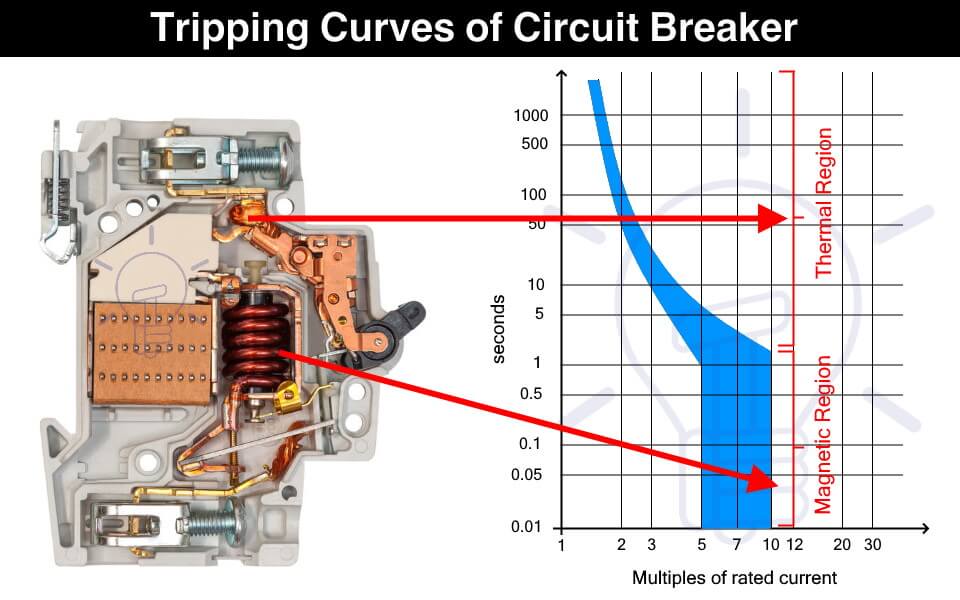
What is a Trip Curve?
A trip curve also known as a current time graph is a graphical representation of the response of a circuit breaker. It shows the current relationship with the tripping time of a protection device.
Why We Need Different Tripping Curves?
Circuit breakers are used for tripping the power supply as quickly as possible in case of overcurrent. But it should not trip so fast & unnecessary that it becomes a problem.
The overcurrent can happen under normal conditions such as the inrush current of a motor. Inrush current is the huge current draw during the starting of a motor that causes voltage dips in the main line. The circuit breaker should be able to tolerate the inrush current & it should provide some delay before tripping.
Therefore, the circuit breaker selected should not trip so fast that it creates a nuisance & it should not trip so late that it causes any damage. This is where the tripping characteristics of the circuit breakers come into play.
The tripping curve tells how fast a circuit breaker will trip at a specific current. The different tripping curves classify the circuit breakers into categories where each category is used for specific types of loads. It is essential to select a circuit breaker that provides the necessary overcurrent protection.
- Types of Circuit Breakers – Working and Applications
- Air Circuit Breaker (ACB): Construction, Operation, Types and Uses
How to read a Trip Curve?
The following figure shows a chart of a trip curve.
The horizontal X-axis represents the multiples of the current flowing through the circuit breaker. While the Y-axis represents the tripping time of the circuit breaker on a logarithmic scale.
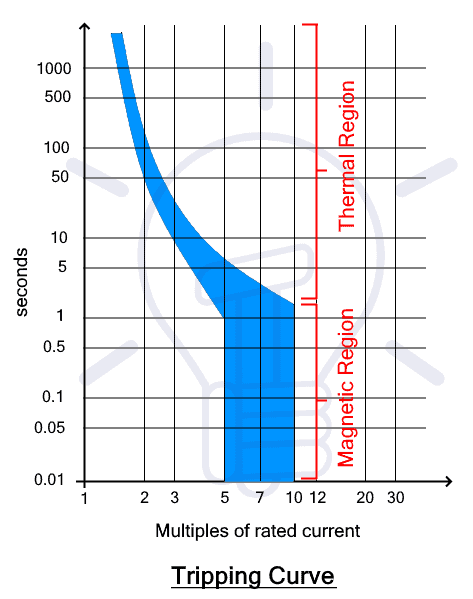
The thermal region shows the response of the bimetallic contact trip unit during overcurrent. The curve shows that the circuit breaker’s tripping time reduces with an increase in the current. The first curve in the graph shows the response of a thermal trip unit.
While the magnetic region shows the response of the solenoid to fault current such as a short circuit current.
As seen from the graph, a circuit breaker does not have a fixed tripping time and we cannot predict an exact tripping point. It is because the tripping is affected by ambient conditions such as temperature. Think of it as a Schrödinger’s Cat area, we do not know when the tripping will occur unless the event happens.
Types of Circuit Breaker Based on Tripping Curves
The circuit breakers are classified into the following five types based on their tripping curves.
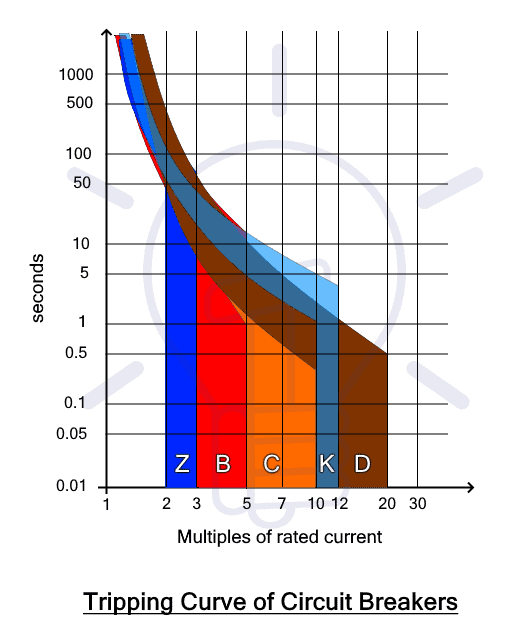
Such type of circuit breaker is designed to instantly trip when the operating current is 3 to 5 times its rated current. Their tripping time falls between 0.04 to 13 seconds. They are suitable for domestic applications where surges are very low such as lighting & resistive loads.

They are sensitive and must not be used in places where the normal surges keep on tripping it unnecessarily.
Type C circuit breaker trips instantly at current surges 5 to 10 times its rated current. its tripping time lies between 0.04 to 5 seconds. As they can tolerate higher surge currents, they are used in commercial applications such as the protection of small motors, transformers, etc.
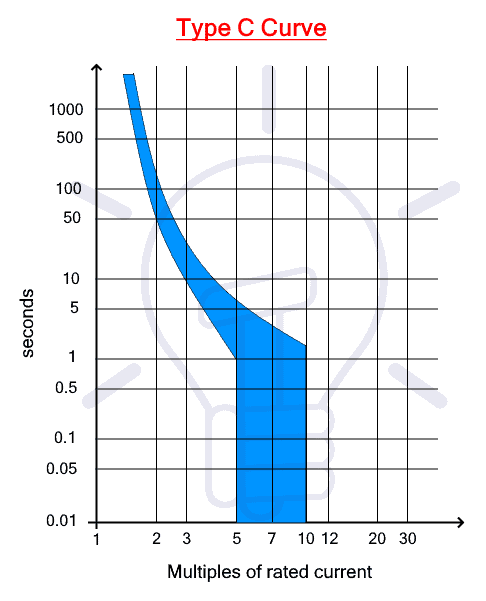
Type D circuit breaker trips instantly when operating current reaches 10 to 20 times its rated current. Its tripping time is 0.04 to 3 seconds. Such circuit breakers can tolerate the high inrush current of large motors. Therefore, they are suitable for running heavy loads in industrial applications.
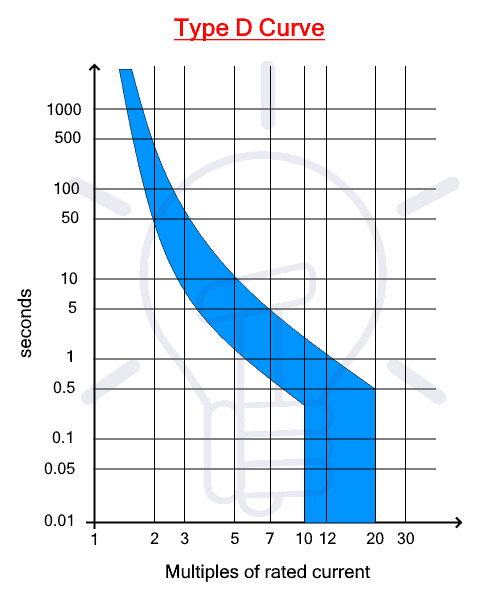
Such type of circuit breakers trips at 10 to 12 times its rated current with a tripping time of 0.04 to 5 seconds. These circuit breakers are also used for heavy inductive loads in industrial applications.
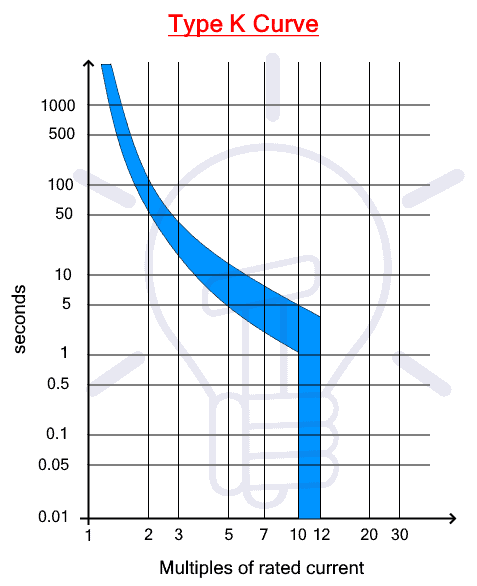
Type Z circuit breakers are the most sensitive circuit breaker that instantly trips when the operating current reaches 2 to 3 times its rated current. They are used for sensitive equipment that requires very low short circuit trip settings.
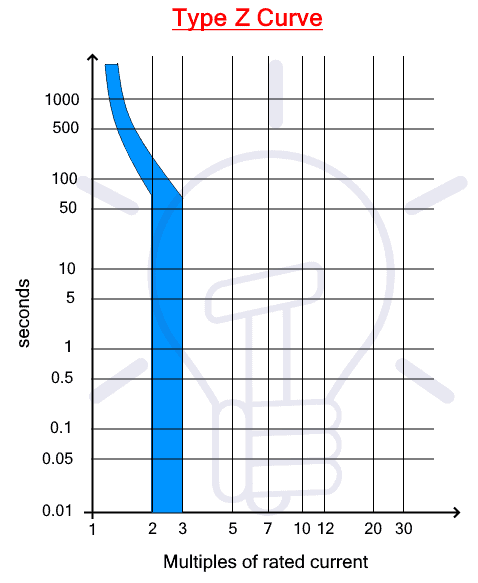
- Main Difference between Fuse and Circuit Breaker
- Difference Between MCB, MCCB, ELCB and RCB, RCD or RCCB Circuit Breakers
- How to Read MCB Nameplate Data printed on it?
- How to Find the Proper Size of Circuit Breaker? Breaker Calculator and Examples
- HVDC Circuit Breaker – Types, Working and Applications
- Can We Use AC Circuit Breaker for DC Circuit and Vice Versa?
- Electronic Circuit Breaker – Schematic and Working
- Smart WiFi Circuit Breaker – Construction, Installation and Working
- Why Circuit Breaker Capacity Was Rated in MVA and Now in kA and kV?
- How to Wire 120V and 240V Main Panel? Breaker Box Installation – US – NEC
- How to Wire Single-Phase, 230V Consumer Unit (Breaker Box) with RCD? IEC, UK and EU
This Post has been published by WWW.ELECTRICALTECHNOLOGY.ORG.
Electrical Technology
Related articles.

A Complete Guide About Solar Panel Installation. Step by Step Procedure with Calculation & Diagrams

How to Calculate the Battery Charging Time & Battery Charging Current – Example

Automatic UPS / Inverter Connection Diagram to the Home Panel Board

How to Find the Proper Size of Wire & Cable: Metric & Imperial Systems

Automatic Street Light Control Circuit using LDR & Transistor BC 547

Emergency LED Light Circuit – DP-716 Rechargeable 30 LED’s Lights Schematic
One comment.
Do we have to consider the tripping curves for DIY installation?
Leave a Reply Cancel reply
Your email address will not be published. Required fields are marked *
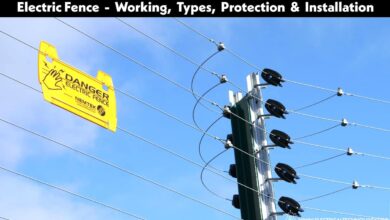
MCB trip curves – A, B, C, D, and more [Explained]
Atul Kumar Pandey
As we all know, MCB (Miniature Circuit Breaker) is a compact electrical switch designed to automatically break and interrupt the flow of electricity in case of over-current or short-circuit, offering protection for circuits and devices in residential as well as commercial applications.
But there are different types of miniature circuit breakers for different applications and one should choose it wisely in order to safeguard appliances from over-current and short-circuit, otherwise it won’t work.
Circuit breaker’s trip curves represent the relationship between the current flowing through the circuit and the time it takes for the circuit breaker to trip or disconnect the circuit once the over-current is there.
Different trip curves are designated by letters such as A, B, C, D, K, and Z. These curves help match the circuit breaker’s response to the specific characteristics of the connected circuit.
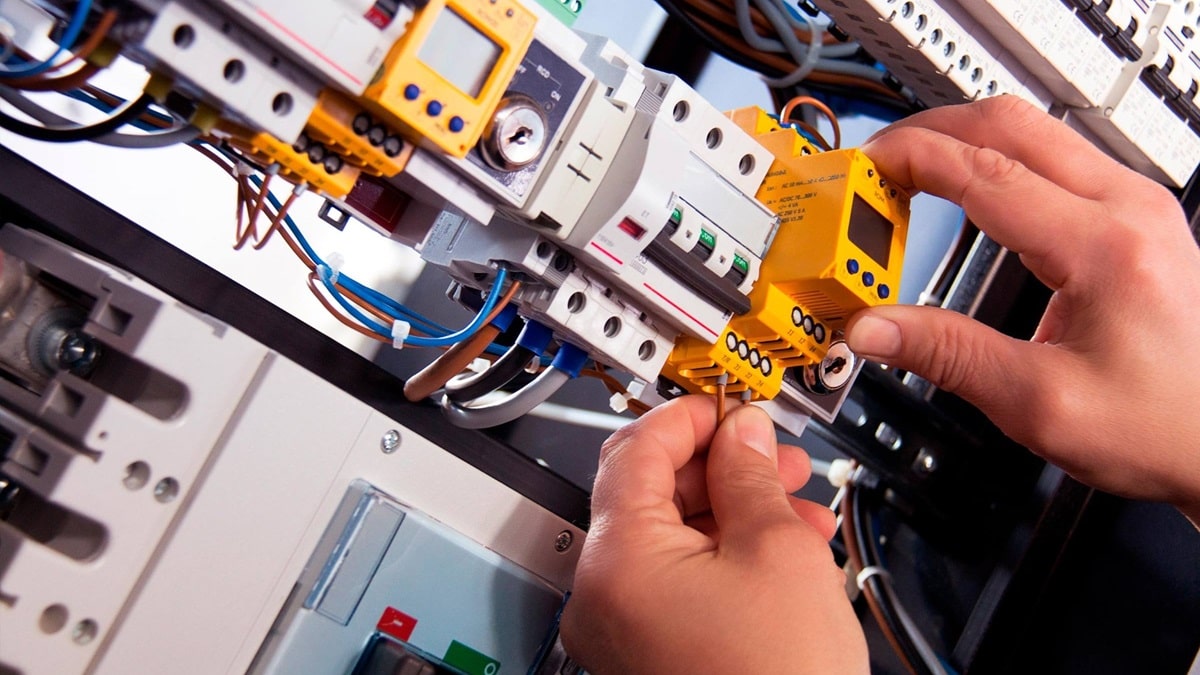
Let’s see all of them one by one and understand what you need for your setup:
A curve – very sensitive.
The ‘A’ curve is designed for circuits with very low inrush currents, offering a fast response to protect sensitive electronic equipment and circuits from minor overloads and short circuits. It trips between 2 and 3 time full load current and commonly used in applications with electronics and computers.
Often recommend to sensitive appliances and mostly used in manufacturing of semiconductors.
Read more about inrush current here .
B curve – moderately sensitive.
The ‘B’ curve is designed for circuits with moderate inrush currents , offering a slower response compared to other curves, making it suitable for residential and light commercial applications where there may be occasional low-level inrush currents during normal operation, offering a balance between sensitivity and selectivity. It trips between 3 and 5 time full load current.
Often recommended to main house cables, water motors or submersible pumps, etc.
C curve – balanced and the most common.
The ‘C’ curve is a general-purpose curve commonly used in residential and commercial applications. It offers a balanced response to both short-circuit and overload conditions, making it suitable for a wide range of electrical circuits, including lighting and small appliances, where a versatile and reliable protection is needed. It trips between 5 and 10 times full load current.
Suitable for a wide range of applications, including lighting circuits and small appliances.
D curve – insensitive.
The ‘D’ curve is designed for circuits with high inrush currents, such as those associated with motors and transformers. It offers a slower response compared to B and C curves, providing effective protection against sustained overloads and short circuits in applications with equipment that has high starting currents or inductive loads. It trips between 10 and 20 times full load current.
Often used in circuits with motors, transformers, and other equipment with high torque currents.
K curve – very insensitive.
The ‘K’ curve is specifically designed for circuits with very high inrush currents, often associated with certain types of lighting or discharge lamps. It has a slower response than the ‘D’ curve, making it suitable for applications with extreme inrush currents, providing effective protection while accommodating the unique characteristics of circuits with high inductive loads. It trips between 8 and 12 times full load current.
Used with heavy-duty load devices like compressors, winding motors, X-ray machines, and certain types of fluorescent lighting or discharge lamps.
Z curve – made for uncommon use.
The ‘Z’ curve, sometimes labeled as ZSI (Zone Selective Interlocking), is designed for applications where selective coordination is crucial. This is not very common type and hard to find in local market.
It is typically used in systems with multiple circuit breakers, where coordination is required to isolate the faulted section of the circuit without unnecessarily tripping upstream breakers.
When selecting a circuit breaker for a particular application, it’s essential to consider the characteristics of the connected circuit, including the type of load, inrush currents, and the need for coordination with other safety devices. The appropriate trip curve ensures that the circuit breaker responds appropriately to different fault conditions while minimizing the risk of unnecessary tripping during normal operation.
Latest on AtulHost

Leave a Reply Cancel reply
Your email address will not be published. Required fields are marked *
Save my name, email, and website in this browser for the next time I comment.
Understanding Miniature Circuit Breaker (MCB) Types and Tripping Curves
- by Bhekusizi Dhlodhlo
- Categories: Blog

Table of Contents
Introduction.
Miniature circuit breakers (MCB) provide protection against short circuits and are rated normally up to 125A. They can be combined with a residual current device, to provide protection against short circuits, overloaded circuits and ground faults.
MCB’s tripping characteristics are represented graphically in a trip curve. The curve shows the response of the thermal and magnetic trip element to various overload and short circuit situations.
Those curves are designated letters according to the circuit breaker type. The circuit breaker Types are B, C, D, K and Z corresponding to similar lettered circuit breaker curves.
Why so many different circuit breaker types?

Circuit breaker curves determine the breaker's reaction time to faults. They're the first line of defence against electrical faults. Learn how to select the correct one! 🛡️ #SafetyFirst #ElectricalEngineering #SparkyCalc Tweet
There so many reasons why we need different circuit breaker types with different trip curves and some of the main reasons are:
Selective Coordination
Different electrical components within a system might have varying levels of fault currents they can handle before tripping.
By using different tripping curves, we can ensure that only the faulty component is disconnected during a fault, allowing the rest of the system to remain operational.
This selective coordination can be achieved by use of circuit breakers with different tripping curves in a system. We discuss this in more detail in our blog on understanding circuit breaker co-ordination
Equipment Protection
Different types of equipment have different thermal and electromagnetic characteristics. A more sensitive trip curve might be suitable for protecting sensitive electronic equipment, while a less sensitive one may be appropriate for heavy-duty machinery. This ensures that the protection device responds appropriately to the specific needs of the equipment.
Start-Up and Inrush Currents
Some devices such as large motors experience higher currents during startup or inrush periods. A circuit breaker that allows the flow of high inrush current without tripping can be used in this instance
Fault Types
Different fault types, such as short circuits and overloads, require distinct response times and current thresholds. Circuit breakers with different tripping curves can be used to address these specific fault conditions appropriately.
Safety and Personnel Protection
Human safety is a critical concern. Tripping curves can be designed to quickly disconnect power in situations where personnel might be at risk, while also preventing unnecessary tripping due to minor fluctuations.
Reading Trip Curves

Reading a Trip curve is not that difficult, give me a sec and I’II explain it to you.

A typical tripping curve is shown above. The horizontal X-axis represents the multiples of the current flowing through the circuit breaker. While the Y-axis represents the tripping time of the circuit breaker on a logarithmic scale. A log scale is used so as to fit a wider range of values on the axis.
The top part of the curve is the thermal section of the trip curve’s responds to overloads which are sustained or long-lasting overcurrent conditions.
Therefore, a circuit breaker with a thermal trip curve is better suited for high-inrush current applications. The thermal trip curve is typically curved, reflecting the fact that the response time of the circuit breaker increases as the level of overcurrent increases. The thermal trip unit responds relatively slowly yet consistently.
The second part of the curve is the magnetic current section of the trip curve responds to short circuits. It relies on a magnetic coil or solenoid opening when the overcurrent’s design limit is reached.
The magnetic trip curve is typically a straight line, reflecting the fact that the response time of the circuit breaker is nearly instantaneous for high levels of current.
The bottom part of the time-current curve shows the performance of the instantaneous trip component (short circuit) of the circuit breaker.
The maximum clearing time (time it takes for breakers to completely open) decreases as current increases. This is because of the blow-apart contact design which utilizes the magnetic field built-up around the contacts.
Breaker types and their trip curves
Now that we’ve learned how to read a trip curve, let’s explore how the type of breaker is linked to these curves and what these curves actually mean.
The first type of circuit breaker that we will look at is the Type B.

Type B circuit breakers have relatively fast tripping characteristics. They are designed to protect sensitive and low-power circuits, such as lighting circuits and some electronic devices.
The standards state that these breakers trip at 4 times the rated current but MCB’s being mechanical devices are not that exact and will trip anywhere between 3 to 5 times the rated current. The tripping characteristics of this circuit breaker is called a B Curve.

The next one on our list is the Type C circuit breaker.

Type C circuit breakers have medium tripping characteristics. They are commonly used in applications like small motors, small transformers, and general domestic applications where a moderate level of inrush current is expected during normal operation.
These breakers provide a balance between protecting against overcurrents and allowing for some temporary overloads. The standards state that they should trip at 7.5 times the rated current but will trip anywhere between 5 to 10 times the rated current. The tripping characteristics of this circuit breaker is called a C Curve.

Next we will discuss the Type D circuit breaker.

Curve D circuit breakers have a delayed tripping characteristic. They are often used in applications with high inrush currents, such as large motors, industrial equipment, and power distribution systems.
These breakers can handle significant overcurrents for a longer time before tripping, which is suitable for equipment that experiences frequent startup surges.
The standards state that they should trip at 12.5 times the rated current but will trip anywhere between 10 to 20 times the rated current. The tripping characteristics of this circuit breaker is called a D Curve.

Lets move on to Type K. This circuit breaker is specifically designed for air conditioning and heat pump systems, which often experience high inrush currents during compressor startup.
Type K provides a delayed response to accommodate these inrush currents while still providing protection against sustained overcurrents. These trip at 8 to 12 times the rated current. The tripping characteristics of this circuit breaker is called a K Curve.

Finally we have Type Z. This circuit breaker is used for specialized applications where the tripping time is extremely fast, even faster than Type A.
It’s often used in situations where human safety is the primary concern, such as in some elevator systems or medical equipment. This circuit breaker trips at 2 to 3 times the rated current. The tripping characteristics of this circuit breaker is called a Z Curve.

Rounding Up
I encourage you to reflect on your current or upcoming projects. Are you using the most appropriate type of MCB? Could a different tripping curve offer better protection or efficiency? If you’re unsure, review the technical aspects we’ve discussed, or consult with a professional.
Your thoughts and experiences are invaluable to this discussion. Please contact me for further discussions. Let’s continue to learn and grow together in our understanding of electrical systems. For more insights, check out similar topics on our blog page and home page . And for updates, don’t forget to subscribe to our newsletter.
Recent Posts
Understanding cable pathways, cable conduits, cable trays, cable pits, understanding ingress protection (ip) ratings, understanding low voltage earthing systems, understanding lv segregation, as/nzs3000, understanding the men system, as/nzs3000, subscribe to our newsletter, get updates and learn from the best, browse some of our featured calculators, want to know when we have new content, i’m here to assist you.
Something in this article isn’t Clear? Feel free to contact me, and I will be more than happy to answer all of your questions.
Share this post

My name is Bheki and I’m an Electrical Engineer. I have a passion for engineering and teaching/mentoring. Qualifications: BEng (Electronic) Hons, MIEAust, CPEng, NER, APEC Engineer IntPE(Aus), RPEQ.
Keep Reading
Copyright © 2024 Powered by SparkyCalc . All rights reserved.
Lets share the love
MCB (Miniature Circuit Breakers) – Types, Working and Trip Curves
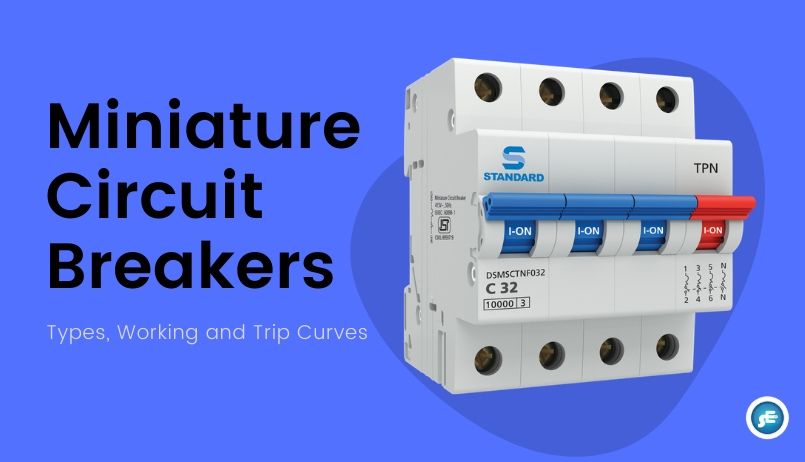
MCB or Miniature Circuit Breaker is an electromechanical device that protects an electric circuit from an overcurrent. The overcurrent in an electrical circuit may result from short circuit , overload or faulty design . This article explains different MCB types, their working and trip curves.
In short, MCB is a device for overload and short circuit protection. They are used in residential & commercial areas. Just like we spend the time to make a thorough check before buying appliances like washing machines or refrigerators, we must also research about Miniature Circuit Breakers.
An MCB is a better alternative to a Fuse since it does not require replacement once an overload is detected. Unlike a fuse, an MCB can be easily operated and thus offers improved operational safety and greater convenience without incurring a large operating cost. They are used to protect lower current circuits and have the following specifications
- Current rating – Amperes
- Short Circuit Rating – Kilo Amperes (kA)
- Operating Characteristics – B, C, D, Z or K Curves
Don’t confuse Miniature circuit breaker with MCCB (Moulded Case Circuit Breaker) or GFCI (Ground Fault Circuit Breaker) .
A Miniature Circuit Breaker is a switchgear which is usually available in the range of 0.5A to 100A . Its Short circuit rating is given in Kiloamps (kA), and this indicates the level of its ability to work.
For example, a domestic MCB would normally have a 6kA fault level, whereas one used in an industrial application may need a unit with a 10kA fault capability.
Table of Contents
Working Principle of Miniature Circuit Breaker (MCB)
MCB’s are protective devices that are made to break the circuit in case of overload or short circuit .
The working of a miniature circuit breaker in case of overload and short circuit fault is,
- For Overload protection , they have a Bi-metallic strip which causes the circuit to open.
- For Short circuit protection , it has an electromagnetic kind of thing.
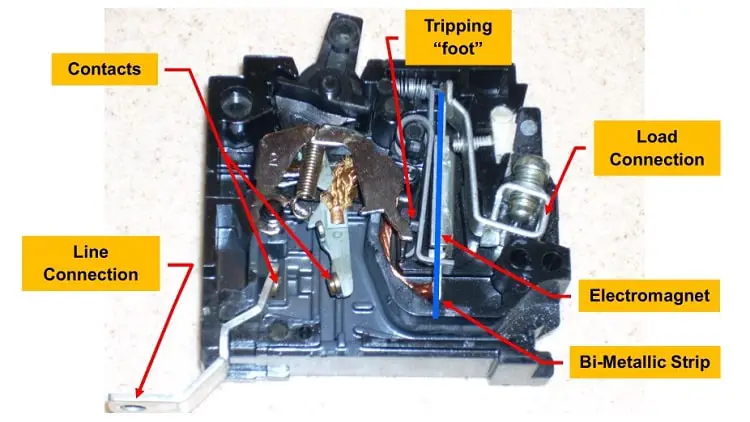
There is two arrangement of operation of a miniature circuit breaker .
- Due to the thermal effect of over electric current
- Due to the electromagnetic effect of overcurrent.
The thermal operation of the miniature circuit breaker is achieved with a bimetallic strip. Whenever continuous over electric current flows through MCB, the bimetallic strip is heated and deflects by bending.
This deflection of bimetallic strip releases the mechanical latch. As this mechanical latch is attached with the operating mechanism, it causes to open the miniature circuit breaker contacts.
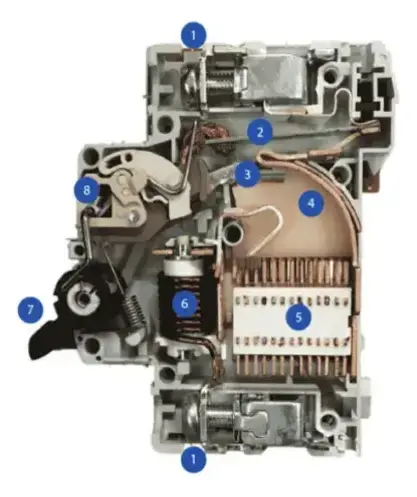
- Terminal for line/load power.
- Bi-metallic strip : Bends with heat (current), separates contacts in response to smaller, longer-term overcurrent, tripping breaker.
- Contacts : Current flows through when closed. Breaks current when separated.
- Arc Chamber : Channels plasma arcing to arc divider.
- Arc divider/extinguisher: Breaks main arc into smaller arcs and extinguishes them.
- Coil/Solenoid: Separates contacts in response to high overcurrents, such as a short circuit.
- Actuator lever: Manually trips or resets breaker.
- Actuator mechanism: Forces contacts together or apart.
But during short circuit condition , the sudden rising of electric current causes electromechanical displacement of plunger associated with tripping coil or solenoid of MCB .
The plunger strikes the trip lever causing an immediate release of latch mechanism consequently open the circuit breaker contacts. This was a simple explanation of a miniature circuit breaker working principle.
Tripping Mechanism in Miniature Circuit Breaker
As explained in the above section, a thermal magnetic MCB has two types of tripping mechanism.
- Thermal Tripping
- Magnetic Tripping
These are explained in the next section.
1. Thermal Trip Unit
The thermal trip unit protects against overload currents.
The thermal unit is based on a bimetal element located behind the circuit breaker trip bar and is part of the breaker’s current-carrying path.
When there is an overload, the increased current flow heats the bimetal causing it to bend. As the bimetal bends it pulls the trip bar which opens the breaker’s contacts.
The time required for the bimetal to bend and trip the breaker varies inversely with the current.
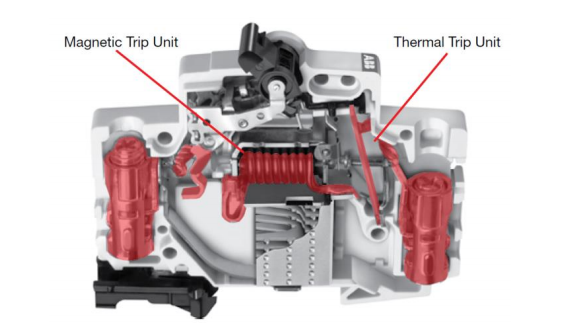

2. Magnetic Trip Unit
The magnetic trip unit protects against a short circuit. The magnetic trip unit is comprised of an electromagnet and an armature.
When there is a short circuit, a high magnitude of current passes through the coils creating a magnetic field that attracts the movable armature towards the fixed armature.
The hammer trip is pushed against the movable contact and the contacts are opened.
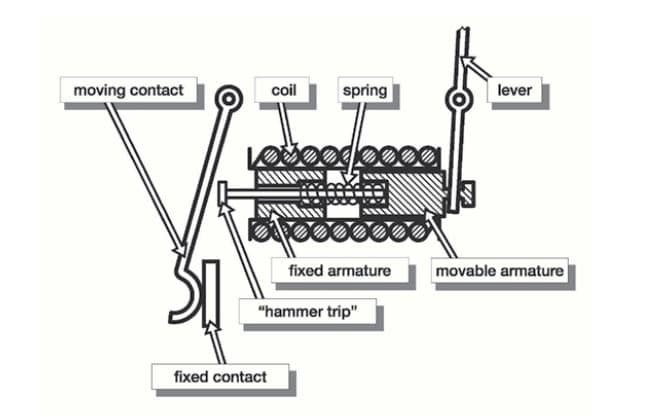
Types of MCB
Miniature Circuit Breakers (MCBs) come in various types, each tailored to specific criteria, ensuring efficient protection for electrical systems. Let’s delve into the main categories:
MCB Types based on Tripping Characteristics:
- Type B MCB: Suited for general circuits, trips at moderate overload currents.
- Type C MCB: Ideal for circuits with motors, trips at higher overload currents.
- Type D MCB: Designed for circuits with high inrush currents like lighting.
- Type K MCB: Sensitive to protect electronic circuits.
- Type Z MCB: Offers high selectivity, vital for complex systems.
Types of MCB based on Principles of Operation:
- Thermal Magnetic MCB: Reacts to both thermal overloads and short circuits.
- Magnetic Hydraulic MCB: Blends magnetic precision with hydraulic control for reliability.
- Assisted Bimetallic MCB: Employs bimetallic strips with additional mechanisms for robust protection.
Types of MCB based on Number of Poles:
- Single Pole (SP) MCB: Basic protection for one circuit.
- Double Pole (DP) MCB: Safeguards both live and neutral conductors.
- Triple Pole (TP) MCB: Extends protection to three conductors.
- Three Poles with Neutral (TPN) MCB: Guards three-phase circuits with a neutral connection.
- Four Pole (4p) MCB: Offers comprehensive protection across all phases and neutral.
Understanding these variations in MCB types enables precise selection for diverse electrical applications, ensuring safety and reliability.
MCB Types based on Tripping Characteristics
MCBs are classified into different types according to tripping over the range of fault current. The important MCB types are as follows:
The tripping current and operating time of each of the above MCB types are given in the table below.
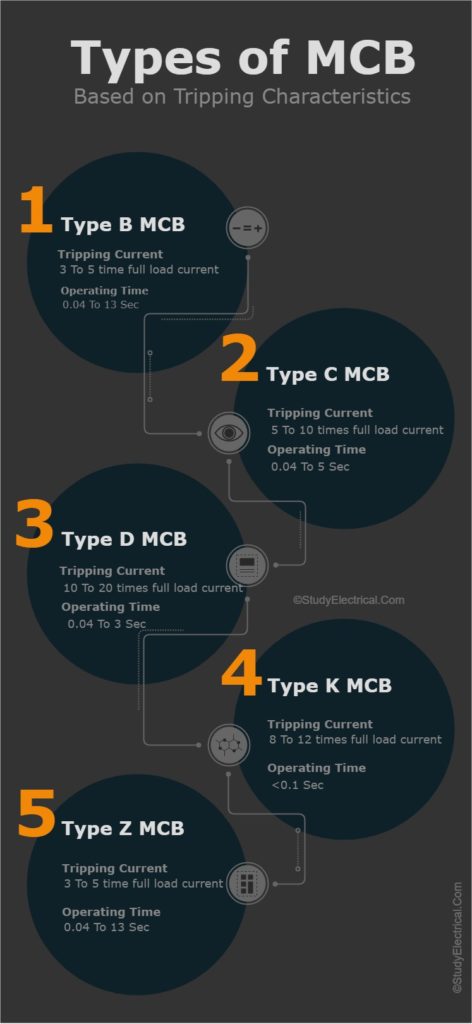
1. Type B MCB
This type of MCB trips between 3 and 5 times full load current.
Type B devices are mainly used in residential applications or light commercial applications where connected loads are primarily lighting fixtures, domestic appliances with mainly resistive elements.
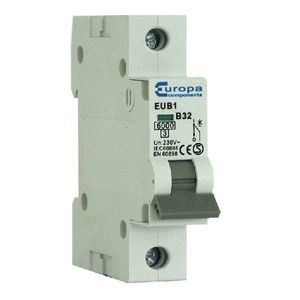
Also used for computers and electronic equipment with very low inrush loads ( PLC wiring ). The surge current levels in such cases are relatively low.
Functions of Type B MCB are protection and control of the circuits against overloads and short-circuits; protection for people and big length cables in TN and IT systems.
Applications : residential, commercial and industrial.
Read more about Type B MCB
2. Type C MCB
This type of MCB trips between 5 and 10 times full load current.
This is used in a commercial or industrial type of applications where there could be chances of higher values of short circuit currents in the circuit.
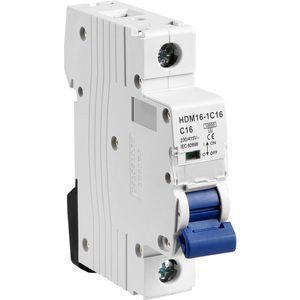
The connected loads are mainly inductive in nature (e.g. induction motors ) or fluorescent lighting. Applications include small transformers, lighting, pilot devices, control circuits, and coils.
Functions of Type C MCB are protection and control of the circuits against overloads and short-circuits; protection for resistive and inductive loads with low inrush current.
3. Type D MCB:
This type of MCB trips between 10 and 20 times full load current.
These MCBs are used in specialty industrial/commercial uses where current inrush can be very high. Examples include transformers or X-ray machines, large winding motors etc.
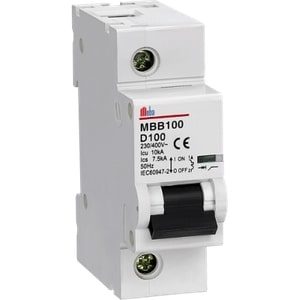
D-curve devices are suitable for applications where high levels of inrush current are expected. The high magnetic trip point prevents nuisance tripping in high inductive applications such as motors, transformers, and power supplies.
F unctions of Type D MCB are protection and control of the circuits against overloads and short-circuits; protection for circuits which supply loads with high inrush current at the circuit closing ( transformers, breakdown lamps).
4. Type K MCB
This type of MCB trips between 8 and 12 times full load current. These are Suitable for inductive and motor loads with high inrush currents.
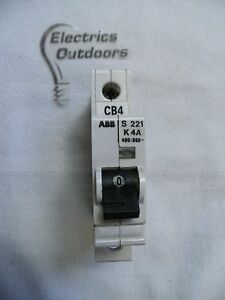
The K and D curve breakers are both designed for motor applications where ampacity rises quickly and momentarily during “start-up.”
Functions of Type K MCB are protection and control of the circuits like motors, transformer, and auxiliary circuits, against overloads and short-circuits.
Advantages of Type K MCB:
No nuisance tripping in the case of functional peak currents up to 8xIn, depending on the series; through its highly sensitive thermostatic bimetal trip, the K-type characteristic offers protection to damageable elements in the overcurrent range; it also provides the best protection to 2 cables and lines.
Applications : Commercial and industrial.
5. Type Z MCB:
This type of MCB trips between 2 to 3 times full load current.
These type of MCBs are highly sensitive to short circuit and are used for the protection of highly sensitive devices such as semiconductor devices.
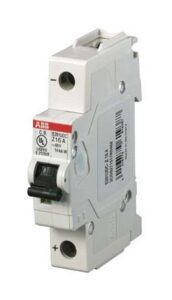
Functions of Type Z MCB are protection and control of the electronic circuits against weak and long duration overloads and short-circuits.
Applications : Commercial and industrial uses.
All the above types of MCBs provide tripping protection within one-tenth of a second.
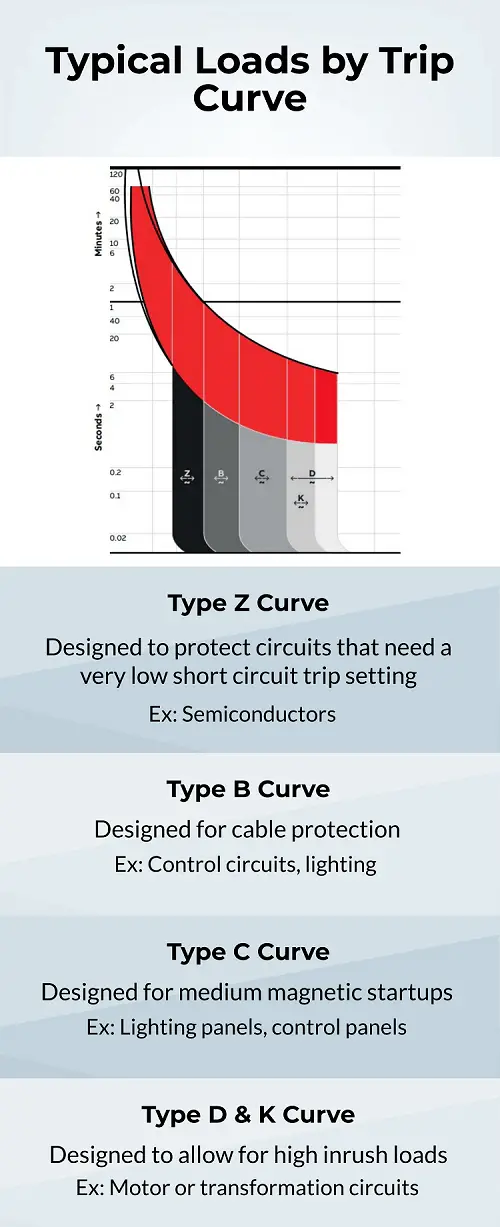
Types of MCB based on Operating Principle
MCBs (Miniature Circuit Breakers) are manufactured with three different principles of operation:
- Thermal magnetic MCB
- Magnetic hydraulic MCB
Assisted Bimetal Tripping MCB
Thermal magnetic mcb:.
- The switching mechanism is housed in a moulded housing with a high mechanically strong switching dolly.
- It incorporates a bimetallic overload release for protection against overload.
- Electric current passes through two contact tips, one on each moving and fixed contact of silver graphite.
- An arcing chamber with de-ionising arc chutes helps in quick suppression of the arc.
- Thermal magnetic release unit provides protection against overload and short circuit.
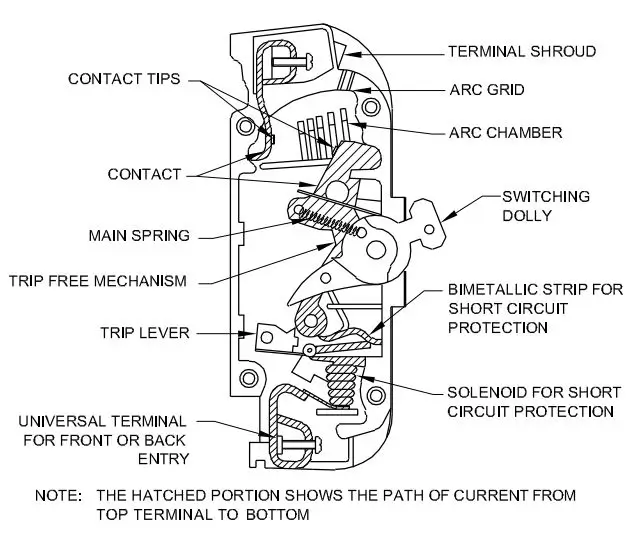
- The bimetallic strip flexes due to temperature rise caused by increasing current.
- At about 130% overload, the bimetallic strip rotates a trip lever, bringing it into the field of a solenoid.
- The solenoid attracts the armature to trip the breaker at about 700% overload or instantaneous short circuit current.
Magnetic Hydraulic MCB:
- Hydraulic magnetic circuit breaker operates on the principle of a solenoid and hydraulically damped plunger.
- A movable ferrous plunger is held against a non-ferrous tube containing polysiloxane liquid.
- The solenoid is a series coil in the circuit.
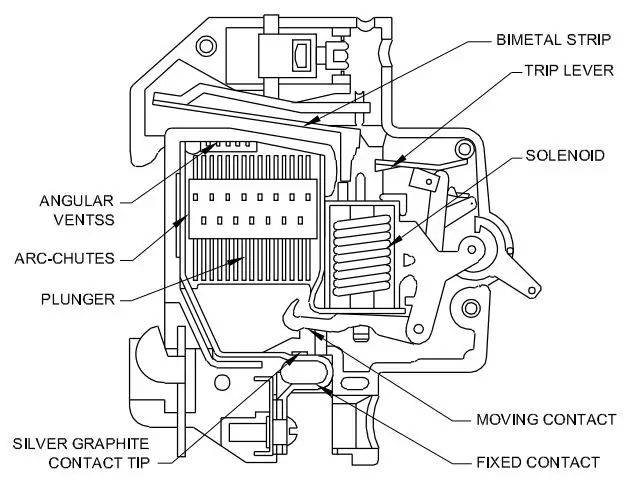
- As the plunger moves towards a pole piece, the reluctance of the magnetic path decreases, leading to an increasing flux.
- The armature is attracted, causing the mechanism to trip and open the circuit on overload or short circuit.
- Instantaneous tripping occurs on very large currents, typically 7 to 8 times the full load current.
In the assisted bimetal form of construction, the time delay characteristic is provided by a thermally operated bimetal element which may be either directly or indirectly heated.
- Time delay characteristic provided by a thermally operated bimetal element.
- Instantaneous tripping in short circuit condition achieved by arranging a powerful magnetic pull to deflect the bimetal.
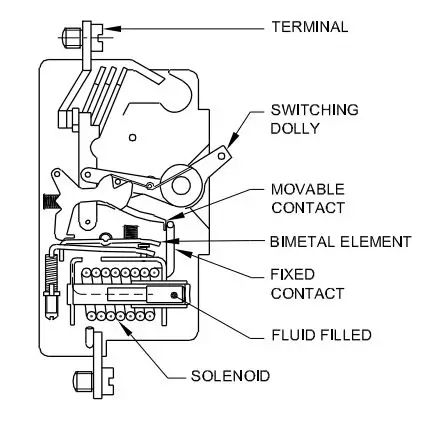
- Utilizes the magnetic field produced when a current flows through the conductor to deflect the bimetal sufficiently to trip the breaker.
Types of MCB based on Number of Poles
Another practical way of distinguishing MCBs is by way of the number of poles supported by the circuit breaker. Based on that, the following types exist:
1. Single Pole (SP) MCB
A single-pole MCB provides switching and protection only for one single phase of a circuit.
2. Double Pole (DP) MCB
A two Pole MCB provides switching and protection both for a phase and the neutral.
3. Triple Pole (TP) MCB
A triple/three phase miniature circuit breaker provides switching and protection only to three phases of the circuit and not to the neutral.
4. Three Pole with Neutral [TPN (3P+N) MCB]
A TPN MCB has switching and protection to all three phases of the circuit and additionally Neutral is also part of the MCB as a separate pole.
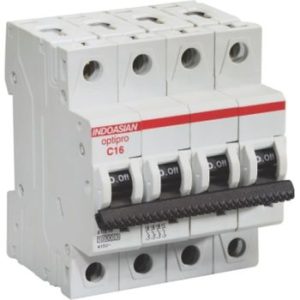
However, Neutral pole is without any protection and can only be switched.
5. Four Pole (4P) MCB
A 4 pole MCB is similar to TPN but additionally, it also has a protective release for the neutral pole.
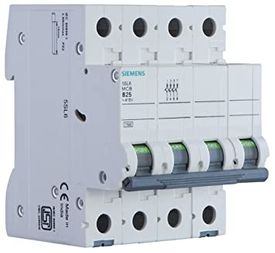
This MCB should be used in cases where there is a possibility of high neutral current flow through the circuit as in cases of an unbalanced circuit.
MCB Characteristic/Trip Curves (Type B,C & D)
In this section, you will learn the characteristics or trip curves of different MCB types. Understanding the trip curves is very important to help you in MCB selection.
What are Trip Curves?
The Characteristic Curve / Trip Curve is the graphical representation of the expected behavior of the circuit protection device.
Circuit protection devices come in many forms, including fuses, miniature circuit breakers, molded case circuit breakers, supplementary protectors, motor protection circuit breakers, overload relays, electronic fuses, and air circuit breakers .
Trip Curve is normally plotted between the release current and tripping time (Time – Current Curve). They are provided by the manufacturers of circuit protection devices to assist users with selecting devices that provide proper equipment protection and performance while avoiding nuisance tripping.

The circuit breaker’s trip curves consist of two parts:
- Tripping of overload protection (thermal tripping device) : The higher the current, the shorter the tripping time
- Tripping of short-circuit protection (magnetic tripping device) : If the current exceeds the threshold of this protection device, the breaking time is less than 10 milliseconds.
The first sloping region of the curve is a graphical representation of the tripping characteristics of the thermal trip unit. This portion of the curve is sloped due to the nature of the thermal trip unit.
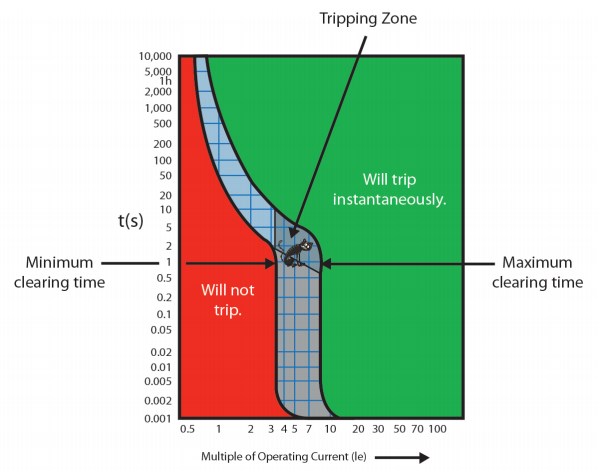
The second region is the response time of the magnetic trip which differentiates each characteristic and for which an identifying letter (Type B, C, D, K, Z) is assigned.
The classification of Type B, C or D is based on fault current rating at which magnetic operation occurs to provide short-time protection (typically less than 100ms) against short circuits.
The most important MCB characteristics are
- Type B characteristic curves.
- Type C characteristic curves.
- Type D characteristic curves.

There are some specialized trip curves such as
- Type S Curve
- Type Z Curve
- Type K Curve
Why do we Need Different Trip Curves?
At this point, one question comes into your mind “What is the need for different types of Trip Curves” or “Why do we need different Trip Curves”.
The role of a circuit breaker is to trip quickly enough to avoid equipment or wiring failure, but not so fast as to give false, or nuisance trips.
It is important that equipment having high inrush currents should not cause the circuit breaker to trip unnecessarily, and yet the device should trip in the event of a short-circuit current that could damage the circuit cables.
We need different trip curves in order to balance the right amount of overcurrent protection against optimal machine operation. Choosing a circuit breaker with a trip curve that trips too soon can result in nuisance tripping. Choosing a circuit breaker that trips too late can result in catastrophic damage to machine and cables.
Now we will look into each of the three important trip curves mentioned above.
1. Type B Curve
Type B devices are generally suitable for domestic applications . They may also be used in light commercial applications where switching surges are low or non-existent.
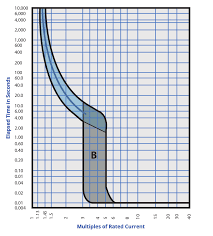
They are designed to trip at fault currents of 3-5 times rated current. For example, a 10A device will trip at 30-50A.
2. Type C Curve
Type C devices are the normal choice for commercial and industrial applications where fluorescent lighting , motors etc. are in use.
These devices are designed to trip at 5-10 times rated current (50-100A for a 10A device).
3. Type D Curve
The Type D devices have more limited applications, normally in industrial use where high inrush currents may be expected.
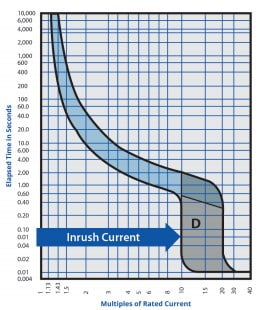
Examples include large battery charging systems, winding motors, transformers , X-ray machines and some types of discharge lighting. Type D devices are designed to trip at 10-20 times (100-200A for a 10A device).
Normal cable ratings relate to continuous service under specified installation conditions. Cables will, of course, carry higher currents for a short time without suffering permanent damage.
Type B and C circuit breakers can generally be selected to achieve tripping times that will protect the circuit conductors against normal surge currents in accordance with BS 7671 . This is more difficult to achieve with Type D devices, which may require a lower earth loop impedance (Zs) to achieve tile operating times required by Regulation 413-02-08.
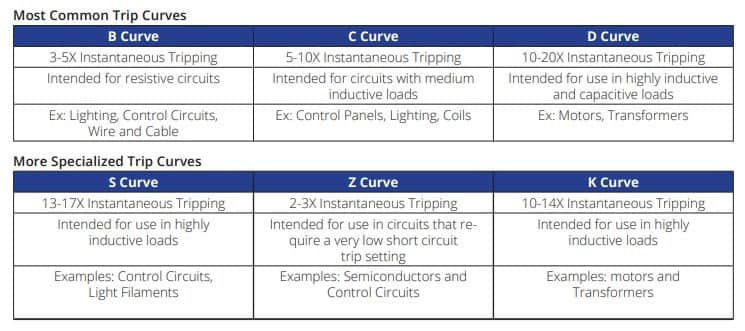
Sources of Surge currents
Surge currents in domestic installations are generally low so that a Type B device is adequate.
For example, inrush currents associated with one or two fluorescent fittings or the compressor motor in a refrigerator/freezer are unlikely to cause unwanted tripping. Fluorescent and other discharge lamps produce surge currents and while one or two fluorescent lamps are unlikely to cause a problem, the block switching of a number of fluorescent lamps.
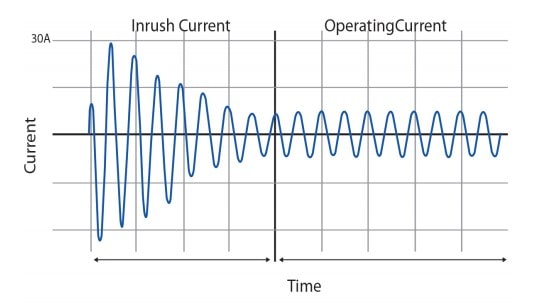
In a shop, office or factory can produce substantial inrush currents. For this reason, Type C devices are recommended for these applications.
The magnitude of the surge current will depend on the lamp rating, starting system, and type of control gear used in the luminaires.
Reputable Miniature Circuit Breaker manufacturers produce tables listing the number of fittings of a particular make and type that can be used with their devices.
Overcoming Unwanted Tripping of MCB
Sometimes the failure of tungsten filament lamps can trip Type B miniature circuit breakers in domestic and retail environments.
This is caused by high arcing currents occurring at the time of failure and is generally associated with inferior quality lamps. If possible the user should be encouraged to use better quality lamps. If the problem persists then one of the measurements listed below should be considered.
A Type C device may be substituted for a Type B device where unwanted tripping persists, especially in commercial applications.
Alternatively, it may be possible to use a higher rating Type B MCB , say 10A rather than 6A.
Whichever solution is adopted, the installation must be in accordance with BS 7671.
A change from Type C to Type D devices should only be taken after careful consideration of the installation conditions, in particular, the operating times required by regulation.
Other Considerations
The importance of selecting circuit-breakers from reputable manufacturers cannot be overemphasized. Some imported products, claiming to have a 6kA short-circuit capacity, had failed dramatically under test.
In contrast, the test procedures followed in British ASCTA (Association of Short Circuit Testing Authorities) laboratories are among the most suitable in the world.
Type B devices should only be used in domestic situations where high inrush currents are unlikely and Type C devices should be used in all other situations.
Selection of Right MCB
The decision to use Type B, C or D miniature circuit breakers for final circuit protection in residential, commercial, industrial or public buildings can be based on a few simple rules.
However, an understanding of the differences between these types of devices can help the installer overcome problems of unwanted tripping or make a suitable selection where lines of demarcation are less clearly defined.
It should be stressed that the primary purpose of circuit protection devices such as miniature circuit breakers and fuses is to protect the cable downstream of the device.
The essential distinction between Type B, C or D devices is based on their ability to handle surge currents without tripping. These are, typically, inrush currents associated with fluorescent and other forms of discharge lighting, induction motors , battery charging equipment, etc.
- Type B, C, and D are used for overcurrent protection of cables in accordance with IEC/EN 60898-1
- Type K for the protecting motors and transformers and simultaneous overcurrent protection of cables with overload tripping based on IEC/EN 60947-2
- Type Z for control circuits with high impedances, voltage converter circuits, and semi cable protection and simultaneous overcurrent protection of cables with overload tripping based on IEC/EN 60947-2.
How To Select Rating Of MCB at a Particular Circuit
If the proper rating is not selected on a particular circuit, there will be no proper functions of MCB at overload. Therefore it is very important to select the right rating of MCB which can be easily calculated as under.
Let’s imagine you have 4 Fans, One TV, 4 Tubes, One V.C.D., One Refrigerator & one 1.5 Ton Air Conditioner on a particular circuit.
The current in that circuit will be (4 x 0.40) + (0.55) + (4×0.20) + (0.22) + (1.6) + (11) = 16 AMP .
Therefore, the suitable rating of MCB will be 20 AMP B Series.
For ready reference current of some important appliance is given below to calculating the preferred rating of MCB.
Calculating Power consumption : 1 Unit = Rs. 4.50 = 1000 watt/hours = 1 Kw/hours.
MCB Selection Table
The MCB selection table helps you to choose the right MCB for protecting your circuit.
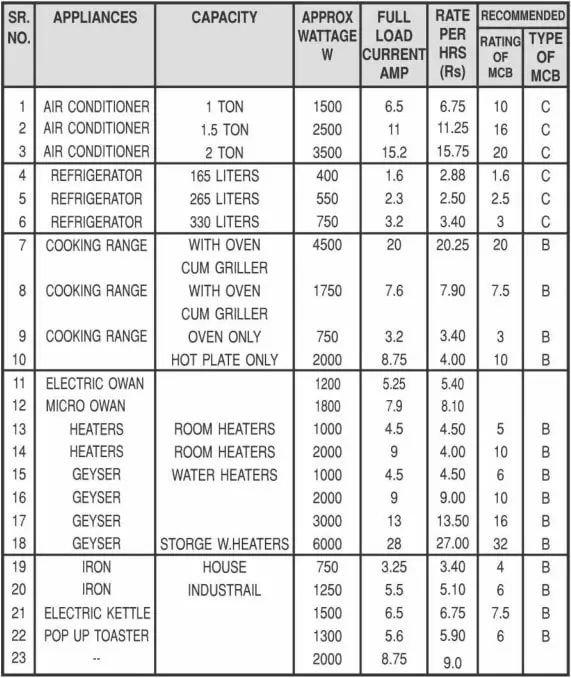
Related Articles
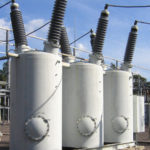
In oil circuit breakers, some insulating oil (e.g., transformer oil) is used as an arc…
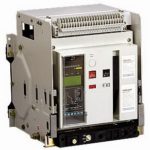
What is an ACB? A circuit breaker in which the contacts open and close in…
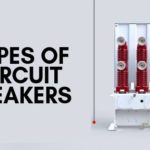
A circuit breaker is a switching device which can be operated manually as well as…

A Type B MCB is a common type of miniature circuit breaker used to protect…

1. What is a Circuit Breaker? Circuit Breaker is a mechanical device designed to close…

QO stands for Qwik-Open. Square D QO Circuit Breakers are fastest tripping circuit breakers at…
25 thoughts on “MCB (Miniature Circuit Breakers) – Types, Working and Trip Curves”
Excellent Article. Cant find anything better than this. Thank you for sharing this.
Nice article, brief detailing of switchgear is provided.
this is great info,i cant find on other .Excellent.
Comprehensive details of MCB great job,
Wow. You have done a great job. Excellent article. Covered literally everything related to Miniature Circuit Breakers. Thankyou.
Very nice, thank u for this article
What mcb would you recommend for use with and EV car charger?
Circuit Breaker type Automatic Transfer Switches are designed to transfer electrical loads from normal power source to emergency power source.
Simply want to say your article is as astounding. The clarity in your post is just nice and i can assume you are an expert on this subject.
Miniature Circuit Breaker is an automatically operated electrical switch designed to protect the electrical appliances.
Thanks Very Nice description
Please tell me that ,why type B is mainly used for resistive Load.
Thanks for publishing such a comprehensive and an informative stuff on breakers.
I think it is really a good article. It helps me better than other articles do. THANKS FOR THIS ARTICLE.
I like this site it’s a master piece! Glad I observed this on google.
It’s very simple to find out any matter on web as compared to textbooks, as I found about Miniature circuit breakers at this site.
I think selecting a circuit breaker depend on the conductor current carrying capacity which must be greater than both the equipment rating and circuit breaker rating to avoid conflict between the two electrical component.
Thanks for giving an excellent reference text on MCBs, great eyeopener.
Very useful
Very very excellent article. Deep knowledge shared in this. Thank you very much. Really appreciated
Very helpful article
Thank you for making me understand MCB, it will be helpful for me for exams
Hi, I want to know the price of all the type C MCB from 5A until 100A
thank you for the article
Thank you for the Article
Leave a Comment Cancel reply


What you need to know about miniature circuit breaker trip curves
One of the critical criteria when selecting miniature circuit breakers is their trip curve. Awareness of these curves will help you select the right breakers for your applications, and diagnose potential nuisance tripping issues.
Trip curve basics Electrical protection devices, with virtually no exceptions, operate based on a simple formula: If THIS, then THIS. If this limit reaches a certain level, then the device executes the designed or programmed action. Today’s large, molded-case circuit breakers may include algorithms consisting of a complex set of If/Then parameters. Miniature circuit breakers (MCBs), on the other hand, operate based on only two parameters: overload and short-circuit.
Still, even with these two basic parameters, breaker buyers face a broad selection of miniature circuit breakers that could potentially meet their application requirements. Selecting the optimum miniature circuit breaker is critical to helping ensure proper protection, with minimal or no nuisance tripping, at the lowest possible cost. Making the right selection requires an understanding of the basics of trip curves.
Understanding trip curves Most protective devices have a defined trip curve, also referred to as a time/current curve, that describes the behavior of the device. The curve is literally a graphic representation of how the device will respond to changes in current. From a functional perspective, the curve parameters specify the high and low current thresholds that will cause the device to trip.
Selecting the appropriate trip curve achieves a good balance between overcurrent protection and optimal machine operation. A fast-acting trip curve will do an excellent job of circuit and production equipment/load protection, but at the cost of frequent and costly nuisance tripping (mostly due to inrush currents of motors and transformers). Choosing a breaker with higher trip points or thresholds will better keep the process up and running, but might cause more temperature rise in cables/conductors and connected loads.
Trip curves are defined by IEC standards 60898-1 and 60947-2. The curves actually represent two different trip functions within the miniature circuit breaker – thermal and electro-magnetic. The thermal section (top section of the chart) that responds to overloads typically consists of a bi-metallic strip. The response of the thermal trip unit is relatively slow. The thermal section, which also complies with UL standards in addition to the before-mentioned IEC standards, is similar across all trip curves.
The short-circuit section (bottom) relies on a magnetic coil or solenoid that opens if the overcurrent design limit is reached. This section of the breaker responds within milliseconds. This characteristic of the trip curve has no counterpart on the UL side.
Trip curve origins The concept of trip curves originated in the IEC world. The alphabetic code used to categorize miniature circuit breakers (B, C, D, K, and Z) carried over from IEC standards. The standard defines the lower and upper thresholds for tripping, but manufacturers have the flexibility to decide the precise specifications within those thresholds that will cause a trip in their products. The trip curve graph shows the tolerance band within which manufacturers can set the individual tripping point of their breakers.
The characteristics and applications of each curve, from most- to least-sensitive are: Z: Trips at 2 to 3 times rated current. Suitable for highly sensitive applications, e.g., semiconductor devices. B: Trips at 3 to 5 times rated current. C: Trips at 5 to 10 times rated current. Suitable for medium inrush currents. K: Trips at 10 to 14 times rated current. Suitable for loads with high inrush currents, mostly for use with motors and transformers. D: Trips at 10 to 20 times rated current. Suitable for high starting currents.
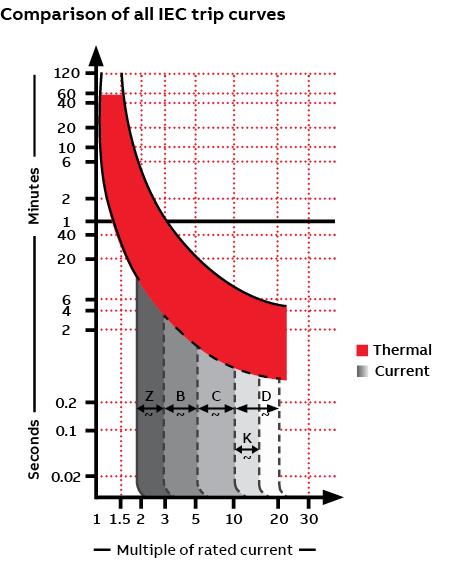
Referring back to the “Comparison of all IEC trip curves” graph, you can see that higher currents trigger more rapid trips.
The ability to tolerate inrush current is an important consideration in trip-curve selection. Certain loads, notably motors and transformers, experience a momentary change in current, the inrush current, at contact closure. Faster protective devices, like a B-trip curve, would see this inrush as a fault and open the circuit. For these types of loads, trip curves with a higher magnetic tripping point, either D or K, can “ride through” the momentary inrush of current, protecting the circuit without nuisance tripping.
Choosing the right trip curve The availability of a range of trip curves and options for different current levels within each range enables selection of an appropriate breaker to protect a variety of loads in various applications.
With large, molded case circuit breakers , you can select one of a number of breakers and then adapt it to the application by adjusting its operating parameters. The same isn’t true for miniature circuit breakers. Their operating parameters are fixed, making it critical that you select the breaker to meet the required specs, including the appropriate trip curve for the application.
Armed with the operating values for a circuit or application/load, it’s possible to make a good selection of the appropriate trip curve. However, this may require some trial and error to arrive at the optimum breaker. Recurring nuisance tripping may be a sign an alternate may be a better fit.
To help ensure the optimal balance between protection and minimal nuisance tripping, the best approach may be to consult with the device manufacturer or distributor. Provide them with the details of your application, and they should be able to recommend the right miniature circuit breakers to meet your needs.
— Thomas Weinmann Senior Product Marketing Manager
ABB Electrification Business
Presented by:

This site is created by ABB application engineers and experts as an educational tool to help engineers.

- Get custom product tools and services
- Access training
- Manage support cases
- Create and manage your orders (authorised partners only)
Welcome to the Schneider Electric Website
Search FAQs
What does b,c,d curve mean for acti 9 mcb.
Released for: Schneider Electric Australia
Articles that might be helpful
Discuss this topic with experts
Start here!
Find answers now. Search for a solution on your own, or connect with one of our experts.
Contact Support
Reach out to our customer support team to receive more information, technical support, assistance with complaints and more.
Where to buy?
Easily find the nearest Schneider Electric distributor in your location.
Search topic-related frequently asked questions to find answers you need.
Contact Sales
Start your sales enquiry online and an expert will connect with you.
Login/Register
Welcome back! Access your account here.
Sign up to an account that suits your needs and take advantage of a customised Clipsal experience.
Frequently asked questions
What is the meaning of the b, c, d, k, and z curves for c60 multi-9 circuit breakers.
19 June 2023
Issue: What do the B curve, C curve, D curve, K curve and Z curve designations mean on Multi 9 breakers? Product Line: Circuit Breakers Resolution: For C60 Multi-9 devices, AC rated, the following is the meaning of the trip curves (in reference to instantaneous trip rating): B curve: 3.2 - 4.8 times amp rating for UL489 and UL1077 (3 - 5 times amp rating for IEC) C curve: 7 - 10 times amp rating D curve: 10 - 14 times amp rating K curve: 10 - 14 times amp rating Z curve: 2.4 to 3.6 times amp rating
UL1077 Miniature Circuit Breakers

Uncompromising safety and comfort
UL1077 miniature circuit breakers (MCBs) ensure electrical safety in multiple applications. UL 1077 MCBs feature two different tripping mechanisms, the delayed thermal tripping mechanism for overload protection, and the magnetic tripping mechanism for short circuit protection.
- Characteristics: B, C, D, K, Z
- Configurations: 1P, 1P+N, 2P, 3P, 3P+N, 4P
- Breaking capacities up to 25 kA
- Rated currents up to 63A
- Real contact position indication, directly connected to the moving contact
- Extra-wide and complete range of MCBs to cover most applications and markets
- Compliance with worldwide product standards (IEC, UL, CSA)
- Space and time-saving thanks to the unique bottom-fixing auxiliary contact
- Established and certified quality
Product Range
- Trip curves B, C, D, K, and Z
- 480Y/277 V AC and 60/125V DC (1-/2-,3-,4- pole)
- 0.2 to 63A
- Trip curves B, C, D, K, Z
- Interrupt rating 10/5 kA (<32 A/35-63 A)
- 277/Y480 VAC max., 60/125 VDC
- Trip curve K
- 277/Y480 VAC
- Interrupt rating 10 kA
- 0.5 to 63 A
- Ring tongue terminals
- Trip curves C, K, Z
- 250/500 VDC
- Interrupt rating 10 kA
- Trip curves B, C, D, K
- 347/Y600 VAC max.
- Interrupt rating 30 kA max.
- 277/Y480 VAC, 500 VDC max.
- 10 to 100 A
- Interrupt rating 20 kA max.
Publications
- Application and Technical
- Catalogs and Buyers Guides
- Certificates/Declarations of Conformity
- Data Sheets
- Drawings-Outline and Dimensional
- Environmental Product Declaration
- White Papers
Other Miniature Circuit Breakers & Supplementary Protectors

IMAGES
VIDEO
COMMENTS
The trip curve of an MCB (B, C, D, K, and Z curves) tells us about the trip current rating of Miniature Circuit breakers. The trip current rating is the minimum current at which the MCB will trip instantaneously. It is required that the trip current must persist for 0.1s. Table of contents. Definition.
Tripping Curves of Circuit Breakers - B, C, D, K and Z Trip Curve Electrical Technology. 1 4 minutes read. Types of Circuit Breaker Based on its Tripping Curve. A circuit breaker is a protection device employed in every electrical circuit to prevent any potential hazard. There are different types of circuit breakers used all over the world ...
Figure 5 (below) shows a B Trip Curve overlaid onto the chart. The three major components of the Trip Curve are: 1. Thermal Trip Curve. This is the trip curve for the bi-metallic strip, which is designed for slower overcurrents to allow for in rush/startup, as described above. 2. Magnetic Trip Curve. This is the trip curve for the coil or solenoid.
Most circuit breakers have two tripping technologies in them which makes the trip curve charts difficult to read. There is a magnetic trip curve for short c...
https://www.AutomationDirect.com/circuit-protection - (VID-CP-0009) Circuit breaker and fuse trip curves (CB Trip curves) explain how a trip occurs based on ...
The 'D' curve is designed for circuits with high inrush currents, such as those associated with motors and transformers. It offers a slower response compared to B and C curves, providing effective protection against sustained overloads and short circuits in applications with equipment that has high starting currents or inductive loads.
MCB's tripping characteristics are represented graphically in a trip curve. The curve shows the response of the thermal and magnetic trip element to various overload and short circuit situations. Those curves are designated letters according to the circuit breaker type. The circuit breaker Types are B, C, D, K and Z corresponding to similar lettered circuit breaker curves
the trip curve has no counterpart on the UL side. Trip curve origins The concept of trip curves originated in the IEC world. The alphabetic code used to categorize miniature circuit breakers (B, C, D, K, and Z) carried over from IEC standards. The standard defines the lower and upper thresholds for tripping, but manufacturers have
What is a trip curve? Simply put, a trip curve is a graphical representation of the expected behavior of a circuit protection device. Choosing the correct tr...
MCB Trip and MCB Curves (B,C,D,K,Z) The concept of trip curves originated in the IEC world. The alphabetic code used to categorize miniature circuit breakers (B, C, D, K, and Z) carried over from IEC standards. The standard defines the lower and upper thresholds for tripping, but manufacturers have the flexibility to decide the precise ...
curves (trip curves, specific let-through energy curves and limitation curves) of the Molded-Case Circuit Breakers (MCCBs) and Low Voltage Power Circuit Breakers (LVPCBs) manufactured by ABB in compliance with the following Standards: - UL 489: Molded-Case Circuit Breakers, Molded-Case Switches and Circuit Breaker Enclosures
A breaker with higher trip points will better keep the process up and running. Trip curves are defined by IEC standards 60898-1 and 60947-2. The curves represent two different trip functions: thermal and electromagnetic. The thermal section (top/red area of the chart) that responds to overloads typically consists of a bi-metallic strip.
MCB or Miniature Circuit Breaker is an electromechanical device that protects an electric circuit from an overcurrent. The overcurrent in an electrical circuit may result from short circuit, overload or faulty design.. This article explains different MCB types, their working and trip curves. In short, MCB is a device for overload and short circuit protection.
Trip curves are standardized according to IEC standards 60898-1 and 60947-2. Modern UL 489 MCBs usually come in three different trip curves—Z, C, and K—though some manufacturers offer B and D trip curves instead of Z and K, respectively. The UL 489 standard describes the tripping/protection requirements for a circuit breaker as follows:
Tripping Characteristics of MCB: B,C,D,K,Z Trip Curves. electricalterminology 3 years ago. Circuit-breakers are used to protect cables in installations. They should disconnect automatically as soon as the combination of the current rise and duration causes the cable or a component to heat up excessively. Circuit-breakers are used for overload ...
All other specifications for standard Bulletin 1489-A products remain unchanged. The ambient temperature derating applies to applications of the device as an IEC Miniature Circuit Breaker (MCB), following 60 947-2 and as Circuit Breaker to UL489/CSA 22.2 No 5.. Ambient temperature refers to the free air temperature in contact with the 1489 device.
Trip curves are defined by IEC standards 60898-1 and 60947-2. The curves actually represent two different trip functions within the miniature circuit breaker - thermal and electro-magnetic. The thermal section (top section of the chart) that responds to overloads typically consists of a bi-metallic strip. The response of the thermal trip unit ...
For C60 Multi-9 devices, AC rated, the following is the meaning of the trip curves (in reference to instantaneous trip rating): B curve: 3.2 - 4.8 times amp rating for UL489 and UL1077 (3 - 5 times amp rating for IEC) C curve: 7 - 10 times amp rating D curve: 10 - 14 times amp rating K curve: 10 - 14 times amp rating Z curve: 2.4 to 3.6 times ...
Not all breakers are the same, select one with the right response time for your application.Helping you become a better technician so you will always be in d...
What does B,C,D curve mean for Acti 9 MCB? B Curve means the MCB trips between 3-5 times full load current. It is mainly used in residential applications where loads are resistive e.g. lighting fixtures, domestic appliances with low surge Levels. C Curve means the MCB trips between 5-10 times full load current. It is used in commercial ...
Miniature Circuit Breaker Migration Guide. 1489-M 1492-SPM 1492-D 188-J, -K 1492-RCDA. Dual terminals wiring/bus bar and clamp from both improve connection.
For C60 Multi-9 devices, AC rated, the following is the meaning of the trip curves (in reference to instantaneous trip rating): B curve: 3.2 - 4.8 times amp rating for UL489 and UL1077 (3 - 5 times amp rating for IEC) C curve: 7 - 10 times amp rating. D curve: 10 - 14 times amp rating. K curve: 10 - 14 times amp rating.
Features Characteristics: B, C, D, K, Z Configurations: 1P, 1P+N, 2P, 3P, 3P+N, 4P Breaking capacities up to 25 kA Rated currents up to 63A Real contact position indication, directly connected to the moving contact Benefits Extra-wide and complete range of MCBs to cover most applications and markets Compliance with worldwide product standards (IEC, UL, CSA) Space and time-saving thanks to the ...